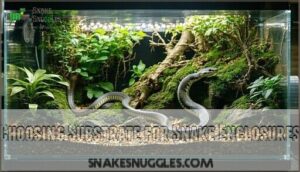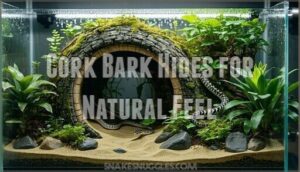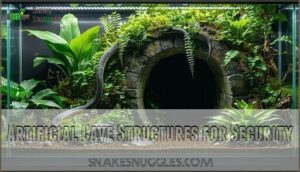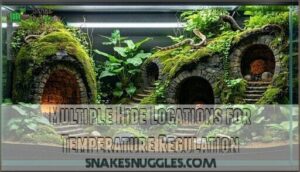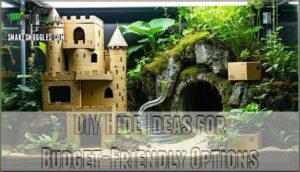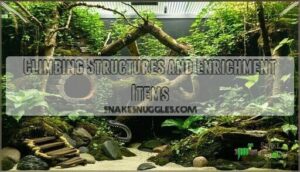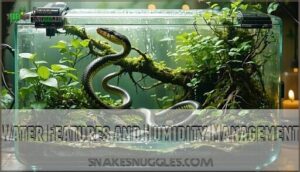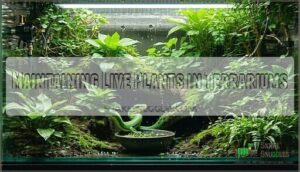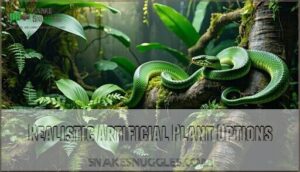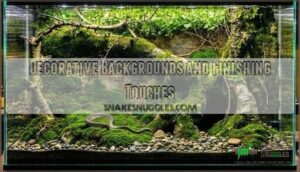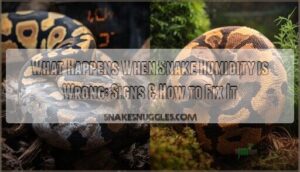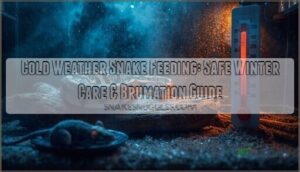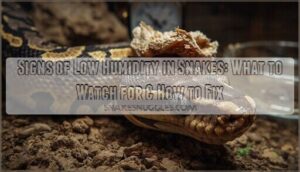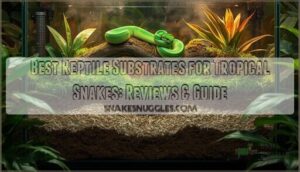This site is supported by our readers. We may earn a commission, at no cost to you, if you purchase through links.
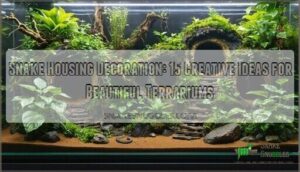 Creating stunning snake housing decoration transforms your pet’s enclosure from basic glass box into enchanting habitat.
Creating stunning snake housing decoration transforms your pet’s enclosure from basic glass box into enchanting habitat.
You’ll need proper substrate depth, multiple hiding spots for temperature regulation, and climbing structures that mimic natural environments.
Cork bark hides provide authentic feel while artificial caves offer easy maintenance.
Live plants boost humidity and aesthetics, though artificial foliage works too.
Strategic lighting creates temperature gradients essential for thermoregulation.
Water features shouldn’t just be functional—they can become focal points.
Smart decorating means balancing your snake’s biological needs with visual appeal that showcases their natural beauty while making maintenance manageable.
It’s about creating an environment that meets your snake’s needs while also being aesthetically pleasing and easy to care for, ultimately leading to a better life for your pet.
Table Of Contents
- Key Takeaways
- Essential Elements of Snake Housing Decoration
- Choosing Substrate for Snake Enclosures
- Hiding Spots and Shelter Options
- Climbing Structures and Enrichment Items
- Water Features and Humidity Management
- Live Plants Vs. Artificial Foliage
- Lighting and Heating Elements
- Decorative Backgrounds and Finishing Touches
- Frequently Asked Questions (FAQs)
- How do you decorate a snake’s home?
- How to design a snake enclosure?
- What can you put in a snake enclosure?
- How do you make a DIY snake habitat?
- What is a DIY snake cage enclosure?
- Do you have to keep a snake in an enclosure?
- What not to put in a snake enclosure?
- What to put on the bottom of a snake enclosure?
- How to keep a snake enclosure cool?
- What do snakes like in their tank?
- Conclusion
Key Takeaways
- Create species-specific environments – You’ll need to research your snake’s natural habitat requirements, since ball pythons need higher humidity than corn snakes, and arboreal species require vertical climbing space, while terrestrial ones need more floor area.
- Balance aesthetics with functionality – You should choose decorative elements that serve dual purposes, like cork bark hides that provide natural textures for shedding, while creating secure retreats, ensuring every item enhances both visual appeal and your snake’s well-being.
- Establish proper temperature and humidity gradients – You’ll create distinct climate zones by positioning heating elements at one end for basking (85-90°F) and maintaining cooler areas (10-15°F lower) at the opposite end, while using water features and substrates to manage humidity levels.
- Prioritize safety and maintenance – You must select non-toxic materials, secure all climbing structures properly, avoid sharp edges or small objects that could cause injury, and choose easy-to-clean substrates and decorations that won’t compromise your snake’s health during regular maintenance.
Essential Elements of Snake Housing Decoration
You’ll transform your snake’s terrarium into an enchanting habitat by combining essential elements that prioritize both beauty and your pet’s health.
Successful decoration requires understanding your snake’s species-specific needs while creating an environment that mimics their natural habitat through carefully selected substrates, hiding spots, and climbing structures, which helps in creating a natural habitat.
Creating a Natural Habitat Environment
Creating a naturalistic terrarium transforms your snake’s world into a living ecosystem that supports their natural behavior patterns.
You’re basically recreating their wild homeland, complete with environmental enrichment that encourages exploration and reduces stress. A well-designed natural habitat incorporates varied habitat textures, proper spatial layout, and natural lighting to create an authentic environment your snake recognizes instinctively.
To achieve this, consider researching reptile care tips for guidance on creating an ideal environment.
- Dense vegetation clusters provide essential cover and hunting grounds for confident movement
- Multi-level terrain with rocks and logs creates natural temperature gradients and basking spots
- Textured substrates like cypress mulch or coconut fiber support natural burrowing behaviors
- Strategic terrarium background elements add depth while maintaining clear sight lines for monitoring
Balancing Aesthetics and Functionality
Your snake’s enclosure should merge functional beauty with practical needs.
Enclosure design must accommodate natural snake behavior while creating a stunning naturalistic terrarium.
Choose reptile enclosure accessories that serve dual purposes—snake hide boxes that complement your terrarium background.
Multi-level structures maximize space efficiency.
Habitat lighting enhances visual appeal while supporting health.
Prioritize decor safety by selecting smooth-edged, non-toxic materials.
Snake habitat decor works best when every element serves both form and function.
Effective snake housing considerations involve understanding proper ventilation systems to maintain a healthy environment.
Addressing Specific Snake Species Needs
Different snake species require customized decoration approaches to thrive.
Ball pythons need tight-fitting hides and humid microclimates, while corn snakes prefer climbing branches and vertical space.
Species Research guides your Habitat Mimicry efforts—arboreal species need height, terrestrial ones need floor space.
Understanding Snake Behavior patterns helps you create Environmental Enrichment that matches their natural instincts.
Species Specificity guarantees your custom snake enclosures truly serve your pet’s needs.
Importance of Proper Enclosure Size
Your snake’s enclosure dimensions directly impact its physical and mental well-being. Space Requirements depend on your snake’s adult size, with most species needing enclosures at least as long as their body length. Snake Length measurements guide minimum floor space calculations, while Enclosure Depth should accommodate natural behaviors like burrowing.
Proper snake enclosure size prevents stress-related health issues and promotes natural movement patterns. Consider these Size Guidelines when planning your snake housing decoration:
- Floor space: Minimum length equals snake’s adult size
- Height considerations: Arboreal species need vertical space for climbing
- Ventilation Needs: Larger enclosures require strategic airflow placement
- Growth planning: Choose enclosure dimensions that accommodate adult size
Quality reptile enclosure materials and thoughtful sizing create healthier, more active snakes.
Choosing Substrate for Snake Enclosures
Your substrate choice directly impacts your snake’s health, cleanliness, and overall enclosure aesthetics.
The right substrate provides comfort, controls humidity, and creates an authentic natural environment that benefits both you and your snake, contributing to the overall aesthetics.
Natural Vs. Synthetic Substrate Options
The foundation of any terrarium starts with what lies beneath your snake’s belly.
Natural substrates like coconut husk and cypress mulch create authentic environments that mirror wild habitats. These organic materials excel at moisture control, helping maintain proper humidity levels.
Synthetic substrates like reptile carpet offer hassle-free cleaning but lack the natural feel.
Consider your snake’s needs when choosing substrate types – burrowing species thrive on deeper natural options while arboreal snakes need less depth. For a low maintenance option, many owners prefer reptile carpet products to line their terrariums.
Moisture-Retaining Properties for Humidity Control
Proper humidity control relies on selecting substrates with strong moisture-retaining properties.
Cypress mulch and coconut fiber act like tiny reservoirs, holding water while releasing it gradually.
Sphagnum moss mixed with other substrates creates localized humidity zones.
These materials maintain stable moisture levels by reducing evaporation rates, ensuring your snake’s environment stays within ideal humidity ranges without constant misting or additional water features.
For superior snake housing, consider the importance of reptile substrate in maintaining a healthy environment.
Easy-to-Clean and Hygienic Substrates
Maintaining proper substrate hygiene transforms your snake’s health and your cleaning routine. Reptile-safe materials like paper towels, reptile carpet, and cypress mulch offer superior sanitization techniques without compromising safety.
- Paper towels provide the easiest cleaning methods – simply remove and replace weekly
- Reptile carpet allows thorough washing and disinfection between uses
- Cypress mulch offers natural antimicrobial properties while remaining easy-to-clean substrates
Substrate Depth Guidelines
Getting substrate thickness right means balancing your snake’s natural behaviors with practical maintenance.
Too shallow won’t satisfy burrowing instincts, while excessive depth complicates cleaning and humidity management.
Ideal substrate depth guidelines:
- Small snakes (under 3 feet): 1-2 inches for basic comfort and easy-to-clean substrates
- Medium snakes (3-5 feet): 2-3 inches allowing moderate burrowing with good moisture control
- Large snakes (over 5 feet): 3-4 inches providing proper substrate layers while maintaining manageable humidity levels
Species-specific needs trump general rules—some snakes require deeper bioactive substrates for natural behaviors, while others thrive with minimal substrate thickness for optimal hygiene.
Hiding Spots and Shelter Options
Your snake needs secure hiding spots to feel safe and reduce stress throughout its enclosure.
Proper hides serve as temperature regulation zones where your snake can retreat to cooler or warmer areas depending on its thermoregulatory needs, which also help in reduce stress.
Cork Bark Hides for Natural Feel
Cork bark hides transform your snake’s enclosure into a naturalistic habitat that mimics their wild environment.
Transform your snake’s habitat into a living work of art with natural cork bark textures and hidden retreats.
These natural hides offer superior bark textures that help with shedding while providing essential snake security.
Unlike plastic alternatives, cork bark breathes naturally and regulates humidity levels around your snake’s hiding spots.
Cork Bark Hide Benefits DIY Cork Bark Hides Safe Cork Bark Sources
Position your cork bark hide in cooler areas of the enclosure.
The curved surfaces create snug spaces where snakes feel protected.
You can stack pieces or hollow out sections for custom hide designs.
Clean cork bark monthly with reptile-safe disinfectants to prevent bacterial growth while preserving the natural texture your snake craves.
Artificial Cave Structures for Security
Artificial cave structures provide your snake with secure retreats that mimic natural hiding spots.
Choose durable materials like resin or high-quality plastic that resist scratching and clean easily. Size matters—your snake should fit snugly inside without feeling cramped.
Position these reptile cave structures in cooler zones to create comfortable hiding spots. Well-designed snake hides with security features reduce stress and promote natural behaviors in your naturalistic habitat.
Multiple Hide Locations for Temperature Regulation
Beyond artificial caves, your snake needs multiple hide locations for temperature regulation.
Position reptile caves at both warm and cool zones, creating thermal gradients that allow precise temperature control. This hide diversity supports thermoregulation without compromising security.
Strategic hide placement includes:
- Warm zone shelter – Place near heat sources (86-90°F for ball pythons)
- Cool zone refuge – Position in cooler areas (72-80°F) for safe retreat
- Intermediate hiding spots – Add middle-gradient options for fine-tuning
- Species-specific sizing – Guarantee a snug fit for security and comfort
- Easy-clean materials – Choose mold-resistant options for health maintenance
This multi-hide system lets your snake move between temperature zones while staying hidden, supporting digestion, shedding, and stress reduction.
Effective snake enclosure temperature control involves creating a thermal gradient with proper temperature zones.
DIY Hide Ideas for Budget-Friendly Options
Budget-conscious snake keepers can create effective DIY snake hide options using household materials.
Cardboard hides work temporarily, while PVC pipes offer durable DIY tunnels.
Repurposed boxes become custom terrarium hide spaces with entrance holes cut strategically.
Foam inserts shape natural-looking caves inside containers.
These reptile hide solutions provide security without expensive commercial alternatives.
Climbing Structures and Enrichment Items
You’ll transform any snake enclosure into an engaging vertical playground when you add sturdy climbing structures that encourage natural behaviors.
These enrichment items provide both essential exercise opportunities and create dynamic viewing experiences as your snake explores branches, platforms, and interactive elements throughout their habitat.
Branches and Logs for Vertical Exploration
Vertical climbing transforms your snake’s habitat into an active playground.
Choose sturdy branches like aspen or cypress with varied wood textures for grip.
Position logs diagonally and horizontally to create snake perches at different heights.
These climbing structures maximize vertical space while mimicking your snake’s naturalistic environment.
Secure all branch types properly to prevent shifting during exploration.
The selection of branches also depends on the availability of suitable snake branches to create a diverse environment.
Sturdy Platforms and Ledges for Basking
Install basking shelves using sturdy platforms made from sealed wood or reptile-safe stone.
Position these ledge designs at different heights to create multiple temperature gradients throughout your enclosure.
Your snake will appreciate multiple snake perches for thermoregulation.
Verify all climbing structures can support your snake’s weight and provide stable basking spots for safe, comfortable heat absorption.
Interactive Toys for Mental Stimulation
Adding interactive toys transforms your snake’s habitat into a dynamic learning environment.
Puzzle feeders challenge natural hunting instincts while maze toys encourage exploration and problem-solving.
Create scent trails using hidden treats to stimulate foraging behaviors.
These environmental enrichment tools boost snake agility and provide essential mental stimulation, keeping your serpent engaged and cognitively sharp.
Water Features and Humidity Management
Water features serve as more than decorative elements in your snake’s habitat—they’re essential tools for maintaining proper humidity levels and supporting your pet’s health.
You’ll need to balance water bowl placement with misting systems to create the ideal microclimate that mimics your snake’s natural environment.
Selecting Appropriate Water Bowls
Your snake’s hydration station deserves careful consideration for ideal health. The water bowl serves multiple purposes beyond drinking, including soaking during shed cycles and maintaining proper humidity levels.
Water Bowl Materials matter substantially for durability and hygiene. Ceramic dishes resist tipping and cleaning easily, while stainless steel options prevent bacterial growth. Avoid porous materials that harbor pathogens.
Bowl Size Guidelines depend on your snake’s dimensions and species requirements:
- Diameter: Choose bowls measuring one-third to one-half your snake’s body length
- Water Depth: Maintain 1-2 inches deep for most species, allowing comfortable soaking
- Bowl Placement: Position away from heat sources to prevent rapid evaporation
Your hydration station becomes a centerpiece when properly sized and positioned for your snake’s natural behaviors.
Incorporating Naturalistic Water Sources
Transform your reptile habitat with carefully crafted water features that mimic natural environments.
Consider shallow pond designs or gentle stream creation using aquarium-safe materials.
Position these aquatic landscaping elements strategically to create drinking spots while maintaining proper water circulation.
Your hydration station becomes both functional and visually appealing when naturalistic water sources blend seamlessly with your terrarium’s ecosystem.
Misting Systems for Increased Humidity
The right misting systems can transform your snake’s habitat into a humidity-controlled paradise.
Fogging Systems and Water Misting setups maintain ideal moisture levels automatically, while Spray Nozzles deliver targeted Evaporative Cooling.
DIY misting systems offer budget-friendly Humidity Control solutions.
Commercial units like MistKing provide programmable schedules, ensuring consistent environmental conditions.
Regular maintenance prevents bacterial buildup and keeps your system running smoothly.
Creating Humidity Gradients Within The Enclosure
Establishing humidity gradients transforms your terrarium into a microclimate paradise.
Position water features and misting systems at one end, creating humid hideouts where moisture-loving species thrive.
Use fog systems strategically to maintain humidity control without oversaturating the entire enclosure.
Heat gradients naturally reduce moisture levels toward basking areas, giving your snake options for ideal comfort and effective moisture management throughout their habitat.
Live Plants Vs. Artificial Foliage
You’ll need to choose between living plants and artificial foliage to create the perfect balance of beauty and practicality in your snake’s habitat.
Living plants offer natural humidity regulation and air purification, while artificial alternatives provide durability and zero maintenance requirements for busy snake keepers.
Benefits of Live Plants for Snake Habitats
Creating a bioactive terrarium with live plants transforms your snake’s habitat into a thriving ecosystem.
Live plants enhance air quality by filtering toxins while maintaining ideal humidity levels through transpiration. They provide enrichment opportunities, encouraging natural snake behavior like exploration and thermoregulation. Proper soil health supports beneficial microorganisms that break down waste naturally.
When selecting plants, it’s vital to think about safe plant species to guarantee the well-being of your snake.
| Benefit | Live Plants | Artificial Plants |
|---|---|---|
| Air Quality | Filters toxins, produces oxygen | No air purification |
| Humidity Control | Natural transpiration maintains levels | No humidity benefits |
| Snake Behavior | Encourages natural exploration | Limited behavioral enrichment |
| Habitat Design | Creates authentic naturalistic environment | Static decorative element |
| Soil Health | Supports beneficial microorganisms | No biological activity |
Plant species selection directly impacts your terrarium’s success, requiring nontoxic plants that thrive in reptile habitat decor conditions.
Safe Plant Species for Snake Enclosures
When selecting nontoxic plants for your snake enclosure, prioritize safety and durability.
Here’s your guide to snake friendly options:
Safe Plant Species
| Plant Type | Benefits |
|---|---|
| Pothos (Epipremnum aureum) | Tolerates varying humidity levels, easy plant care |
| Snake Plant (Dracaena trifasciata) | Thrives in low light, minimal maintenance |
| Spider Plant (Chlorophytum comosum) | Non-toxic, adaptable to different conditions |
| Bromeliads (Neoregelia spp.) | Vibrant colors, safe for tropical species |
Always avoid plants containing calcium oxalate crystals or alkaloids – check any toxic plant list before purchasing.
Unlike artificial plants, live plants help regulate humidity and create naturalistic water sources.
They’re made from reptile safe materials that won’t harm your snake if accidentally ingested.
These native plants work well in bioactive setups too.
Maintaining Live Plants in Terrariums
Live plants thrive in terrariums when you master proper water management and soil quality. Choose well-draining potting mix to prevent root rot, and maintain consistent humidity control around 40-60%.
Regular pruning techniques keep growth manageable, while monthly fertilization methods support healthy development.
| Plant Care Tips | Frequency | Key Focus |
|---|---|---|
| Water Management | Weekly check | Soil moisture levels |
| Pruning Techniques | Monthly | Remove dead/overgrown foliage |
| Fertilization Methods | Every 4-6 weeks | Diluted liquid fertilizer |
Proper terrarium lighting guarantees photosynthesis without overheating your snake’s habitat.
Use reptile safe materials for all plant containers and supports.
Realistic Artificial Plant Options
Three key factors determine artificial plant success: material safety, realistic appearance, and easy maintenance.
Choose artificial plants for snakes made from non-toxic materials without small detachable parts that could pose ingestion risks.
| Plant Materials | Safety Rating | Maintenance Level |
|---|---|---|
| Silk artificial foliage | High | Low |
| Plastic fake plants | Medium | Medium |
| Fabric artificial greens | High | High |
| PVC leaf textures | Low | Low |
Quality artificial plants mimic natural leaf textures and branching patterns found in nontoxic live plants.
Avoid cheap fake foliage with sharp edges or unstable bases.
Position plant arrangements strategically to create natural-looking cover while allowing easy access for cleaning.
Regular disinfection prevents bacterial buildup that live plants naturally resist through their biological processes.
Well-chosen artificial plants provide long-term beauty without the complexity of maintaining living systems.
Lighting and Heating Elements
Proper lighting and heating create the foundation for successful snake housing decoration by establishing natural temperature gradients and supporting both your pet’s health and your decorative plants.
You’ll need to balance functional heating elements with aesthetic appeal, integrating UVB lighting, heat sources, and temperature control systems that enhance rather than detract from your terrarium’s visual design, which includes creating a natural environment with temperature gradients and aesthetic appeal.
UVB Lighting for Vitamin D3 Synthesis
UVB lighting supports your snake’s health by enabling natural Vitamin D3 synthesis through wavelengths between 290-315 nm.
A high-quality UVB bulb positioned 10-45 cm overhead creates ideal conditions.
Most snakes need Ferguson Zone 2 levels (UVI 2.0-3.0) at basking spots, but requirements vary by species and natural behavior patterns.
UVB Benefits for snake health include:
- Enhanced calcium absorption preventing metabolic bone disease
- Improved immune system function and infection resistance
- Better Lighting Cycles supporting natural circadian rhythms
- Increased appetite and natural basking behaviors
- Antimicrobial properties controlling skin bacteria and fungi
Replace bulbs every 12 months for consistent output.
Monitor UVB Safety by providing shade options and measuring UVI levels with a Solarmeter 6.5.
Balance exposure carefully – overexposure causes skin damage while inadequate lighting compromises Reptile Health.
When selecting a new bulb, consider purchasing from a reputable supplier of UVB Light Bulbs to guarantee superior performance and safety.
Heat Lamps and Ceramic Heat Emitters
Heat lamps provide an accessible heating solution for snake terrariums, offering both warmth and visibility. They’re cost-effective thermal management tools that create natural basking spots your snake will appreciate.
However, proper temperature control requires careful positioning and monitoring.
Consider these heat source options for ideal heat distribution:
- Heat lamps – Provide radiant heat and visible light for daytime basking behavior
- Ceramic heat emitters – Deliver consistent warmth without disrupting natural day/night cycles
- Combination systems – Use both types for thorough thermal management across different zones
While heat lamps excel at creating temperature gradients, they pose fire risks without proper fixtures. Ceramic emitters cost more initially but offer superior temperature control and longevity. Both require thermostats for safe operation and consistent heating performance.
Under-Tank Heating Pads and Thermostats
Under-tank heating pads serve as your snake’s personal heating element, adhering directly beneath the enclosure to create consistent warmth.
Select pads covering 30-50% of your tank’s floor area for ideal temperature gradients.
Thermostat settings between 88-92°F prevent overheating and maintain precise temperature control.
Tank insulation around the pad edges maximizes efficiency while reducing energy costs.
| Heat Source Component | Recommended Specification |
|---|---|
| Heat mat for snakes coverage | 30-50% of tank floor |
| Thermostats accuracy range | ±2°F temperature variance |
| Undertank heating pads wattage | 10-15 watts per square foot |
| Pad thickness | 2-4mm for optimal heat transfer |
| Lifespan expectancy | 3-5 years with proper maintenance |
Monitor your heating elements regularly since pads degrade over time.
Position thermostats’ probes directly above the pad for accurate readings.
Creating Proper Temperature Gradients
Temperature gradients transform your snake’s enclosure into distinct climate zones that mirror their natural habitat.
You’ll create thermal diversity by establishing:
- Basking zone – Position heat sources at one end for 85-90°F surface temperatures
- Cool retreat – Maintain the opposite end 10-15°F cooler for thermoregulation
- Gradient monitoring – Use digital thermometers to track temperature control across zones
- Thermostat integration – Connect your heat mat for snakes and ceramic heat emitter to prevent overheating
This undertank heating pad setup with proper thermal monitoring guarantees your snake can self-regulate body temperature naturally.
Decorative Backgrounds and Finishing Touches
The background serves as your terrarium’s foundation, creating depth and visual interest that transforms a simple enclosure into a fascinating habitat.
You’ll want to balance stunning aesthetics with practical maintenance needs, ensuring your decorative choices enhance both your snake’s well-being and your viewing experience.
3D Textured Backgrounds for Realism
3D textured backgrounds transform flat enclosure walls into rocky landscapes that mirror your snake’s natural habitat.
These foam carvings create realistic rock formations using expandable foam, sealant, and paint. Background materials like cork panels or 3D modeling compounds offer depth and climbing surfaces.
DIY background projects let you customize natural textures specific to your species’ environment. While reptile habitat decor requires more cleaning around crevices, the dramatic visual impact makes maintenance worthwhile for dedicated keepers.
Incorporating Natural Elements Like Rocks
Beyond creating stunning 3D backgrounds, natural elements like rocks transform your snake’s habitat into an authentic ecosystem.
Rock decor provides essential basking spots while creating natural textures that encourage healthy shedding behaviors.
Strategic stone selection matters. River rocks offer smooth surfaces perfect for snake navigation, while textured rocks create visual interest and climbing opportunities.
Your rocky enclosure benefits from varied pebble arrangements:
- Gravel usage: Layer small stones beneath larger rocks for drainage and natural substrate variation
- Rock piles: Stack flat stones in corners to create secure hiding spots and temperature gradients
- Textured surfaces: Choose rocks with different surface patterns to assist with shedding cycles
- Weight distribution: Position heavier stones on the enclosure floor to prevent shifting or collapse
Clean all stones thoroughly with reptile-safe disinfectant before installation. Avoid sharp-edged specimens that could injure your snake during exploration or feeding activities.
When designing the enclosure, consider the importance of bioactive substrate to create a thriving environment for your snake.
Balancing Aesthetics With Easy Maintenance
Looking at your snake tank decorations, you’ll want materials that look great but won’t turn cleaning into a nightmare.
Smart reptile habitat decor choices make all the difference for both snake safety and your sanity.
Here are key maintenance hacks for aesthetic balance:
- Choose sealed surfaces – Varnished wood and ceramic pieces resist staining and wipe clean easily
- Select removable elements – Modular DIY decor allows thorough substrate changes without hassle
- Pick non-porous materials – Cork bark and resin hides resist moisture damage and bacterial growth
- Use spacesaving decor – Multipurpose items like hollow logs serve as both hides and climbing structures
Smart enclosure design means your easytoclean substrates and decor work together, creating stunning visuals while keeping maintenance simple.
Frequently Asked Questions (FAQs)
How do you decorate a snake’s home?
You’ll create a naturalistic environment using cork bark hides, artificial plants, and climbing branches.
Add textured surfaces like rocks for shedding assistance, appropriate substrate, and secure water dishes for ideal snake comfort.
How to design a snake enclosure?
Like architects designing a blueprint before construction, you’ll need to map your snake’s needs before building.
Start with appropriate dimensions – length should be twice your snake’s body length.
Choose materials like plywood or melamine for durability, add proper ventilation, secure latches, and plan for heating zones.
What can you put in a snake enclosure?
You can add hides, water bowls, climbing branches, substrate, artificial plants, cork bark, rocks, and basking platforms to create a naturalistic environment that meets your snake’s behavioral needs.
How do you make a DIY snake habitat?
Nearly 70% of reptile keepers build custom enclosures rather than buying commercial setups.
You’ll need plywood, plexiglass, screws, and basic tools.
Cut wooden panels, assemble the frame, install ventilation, add substrate, and incorporate hiding spots with natural decor elements to create a suitable environment for your reptiles.
What is a DIY snake cage enclosure?
A DIY snake cage enclosure is a custom-built reptile habitat you construct using materials like plywood, plexiglass, and hardware.
You’ll design it to fit your snake’s specific needs and your space constraints, creating a secure, functional home.
Do you have to keep a snake in an enclosure?
Think of your snake as a wild river that needs secure banks to flow safely.
You must provide a proper enclosure for your snake’s health and safety.
Free-roaming poses serious risks including escape, injury, temperature regulation issues, and stress from unfamiliar environments.
What not to put in a snake enclosure?
Avoid cedar, pine, or redwood substrates that emit toxic oils.
Don’t use sharp rocks, small objects snakes could swallow, or unstable decorations.
Skip toxic plants, untreated wood, or items with chemical residues.
What to put on the bottom of a snake enclosure?
Like a foundation anchoring a towering oak, your substrate choice determines your snake’s comfort and health.
Choose paper towels for easy cleaning, cypress mulch for natural appeal, or aspen shavings for burrowing species—each providing secure footing.
How to keep a snake enclosure cool?
You’ll want to control ambient temperature, improve ventilation, and use cooling methods.
Place the enclosure away from heat sources like windows or radiators.
Install fans for air circulation, use ceramic heat emitters sparingly, and consider cooling pads during hot weather.
What do snakes like in their tank?
Snakes thrive with secure hiding spots, fresh water bowls, appropriate substrates like cypress mulch, and naturalistic decor including branches for climbing and textured surfaces for shedding assistance.
Conclusion
Perfect snake housing decoration requires balancing multiple elements: proper substrate depth, strategic hide placement, and functional lighting systems.
You’ll create temperature gradients through careful equipment positioning, establish humidity zones using water features, and incorporate climbing structures for behavioral enrichment.
Remember that successful snake housing decoration depends on species-specific requirements—ball pythons need higher humidity than corn snakes, while arboreal species require vertical space.
Your decorative choices directly impact your snake’s health, stress levels, and natural behaviors, making it crucial to consider these factors for optimal snake care and well-being.
- https://www.reptilecentre.com/blogs/reptile-blog/corn-snake-enclosure-ideas
- https://community.morphmarket.com/t/reptile-decorations-and-safety/10021
- https://reptifiles.com/ball-python-care-guide/ball-python-terrarium-decorations/
- https://www.reddit.com/r/snakes/comments/117pb5y/what_are_your_favorite_cheapdiy_decorclutter_for/
- https://oaklandnaturalareas.com/2022/09/08/bogs-the-peculiar-land-of-sphagnum-moss/

